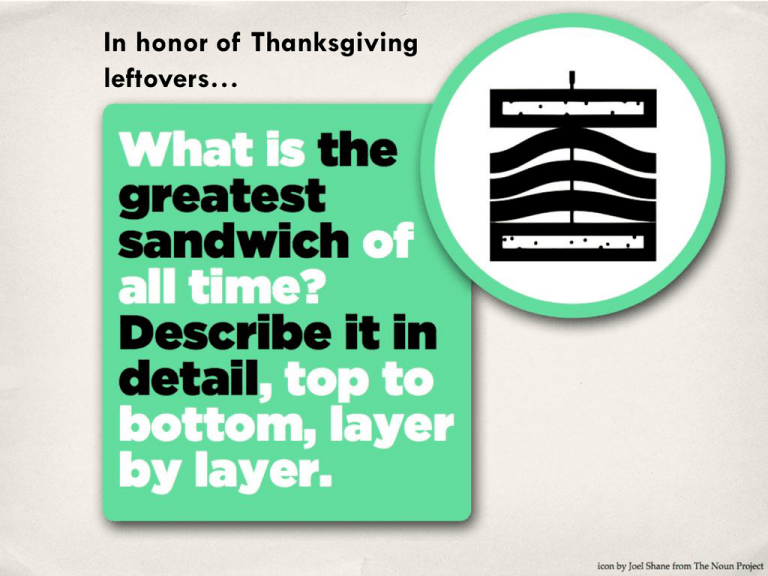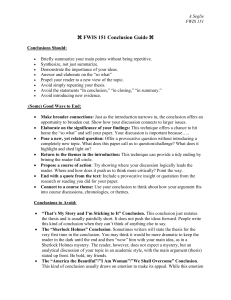Writing a Strong Introduction and Conclusion
advertisement

In honor of Thanksgiving leftovers… WRITING A STRONG INTRODUCTION AND CONCLUSION Writing Notes Introductions What’s the point? First impressions Initial impressions of your argument, writing style, and quality of work especially important when the audience you are trying to reach (your teacher) will be grading your work Road map Gives reader a sense of what points you will cover Capture interest People should want to read your paper Why is the topic important? Consider the following topic: Education has long been considered a major force for American social change, righting the wrongs of our society. Drawing on the Narrative of the Life of Frederick Douglass, discuss the relationship between education and slavery in 19th-century America. Consider the following: How did white control of education reinforce slavery? How did Douglass and other enslaved African Americans view education while they endured slavery? And what role did education play in the acquisition of freedom? Most importantly, consider the degree to which education was or was not a major force for social change with regard to slavery. Strategies Tip #1: Start by thinking about the question (or questions) you are trying to answer. Your entire essay will be a response to this question, and your introduction is the first step toward that end. Your direct answer to the assigned question will be your thesis, and your thesis will be included in your introduction, so it is a good idea to use the question as a jumping off point. The prompt itself can also give you some clues about how to approach the introduction. Notice that it starts with a broad statement, that education has been considered a major force for social change, and then narrows to focus on specific questions from the book. One strategy might be to use a similar model in your own introduction —start off with a big picture sentence or two about the power of education as a force for change as a way of getting your reader interested and then focus in on the details of your argument about Douglass. Strategies Tip #2: Decide how general or broad your opening should be Keep in mind that even a “big picture” opening needs to be clearly related to your topic An opening sentence that said “Human beings, more than any other creatures on earth, are capable of learning” would be too broad for our sample assignment about slavery and education. the introductory sentence about human beings is mismatched—it’s definitely too broad and doesn’t come close to addressing the specific topic. When writing, you need to place your ideas in context. Strategies Tip #3: Write your introduction last An introduction written at the beginning will not necessarily reflect what you wind up with at the end Devise your thesis (your argument) and then start the body paragraphs When you have finished your essay, read over your main points and create an introduction that is reflective of your work Strategies Tip #4: Never announce your intentions Avoid statements like “In this paper, I will argue that Frederick Douglass valued education.” While this sentence points toward your main argument, it isn’t especially interesting. It is much more convincing to tell us “Frederick Douglass valued education” than to tell us that you are going to say that he did. Assert your main argument confidently. After all, you can’t expect your reader to believe it if it doesn’t sound like you believe it! Formula Hook: Attract the reader's interest by telling them that this paper relates to something interesting. What makes a topic interesting? Some combination of the following attributes makes X something worth looking at. X matters: When X rises or falls, people are hurt or helped. X is puzzling: it defies easy explanation. X is controversial: some argue one thing while other say another. X is big (like public education) or common (like traffic jams). Formula Background: What information should your reader have before delving into your paper? How can you transport the reader from wherever they are to the “setting” of your paper? Formula Address the Question: Tell the reader what this paper actually does. Think of this as the point in a trial where having detailed the crime, you now identify a suspect and promise to provide a persuasive case. The reader should have an idea of a topic question that will have a more or less satisfactory answer by the end of the paper. Formula Thesis: What is your arguable point? Refer to thesis notes This might get rolled into one of your other introductory elements Formula Road-map: Outline the organization of the paper. Avoid writing an outline so generic that it could apply to any paper ("the next section is the middle of the paper and then we have the end"). Instead customize the road map to the project and possibly mention pivotal "landmarks“ that will be seen along the way. problems, solutions, results Character A, Character B, Character C Keep this short! Intros to Avoid The place holder introduction. When you don’t have much to say on a given topic, it is easy to create this kind of introduction. Essentially, this kind of weaker introduction contains several sentences that are vague and don’t really say much. They exist just to take up the “introduction space” in your paper. If you had something more effective to say, you would probably say it, but in the meantime this paragraph is just a place holder. Example: Slavery was one of the greatest tragedies in American history. There were many different aspects of slavery. Each created different kinds of problems for enslaved people. Recap Formula = Hook + Background + Address Question + Thesis + Road Map Never announce your intentions Determine how broad or specific your intro should be before beginning Avoid common intro errors Sample Intro Given all of the freedoms that were denied enslaved individuals in the American South, one might wonder why Frederick Douglass focused his attentions so squarely on education and literacy. In the 1800s, slavery was a way of life in the American South. Slaves had no real way to educate themselves, meaning that few knew how to read or write. For Frederick Douglass, education was the major force for social change in regard to slavery. Not only did it provide important life skills, it also improved slaves’ sense of self worth, and ultimately helped them aquire freedom. Conclusions What’s the Point? Your conclusion is your chance to have the last word on the subject. Allows you to have the final say on the issues you have raised in your paper, to summarize your thoughts, to demonstrate the importance of your ideas, and to propel your reader to a new view of the subject. It is also your opportunity to make a good final impression and to end on a positive note. Formula Answer the question "So What?" Synthesize, don't summarize Don't simply repeat things that were in your paper. They have read it. Show them how the points you made and the support and examples you used were not random, but fit together. Redirect your readers Show your readers why this paper was important. Show them that your paper was meaningful and useful. Address your thesis one last time Give your reader something to think about, perhaps a way to use your paper in the "real" world. If your introduction went from general to specific, make your conclusion go from specific to general. Create a new meaning You don't have to give new information to create a new meaning. By demonstrating how your ideas work together, you can create a new picture. Often the sum of the paper is worth more than its parts. Strategies Play the “So What” Game. If you’re stuck and feel like your conclusion isn’t saying anything new or interesting, play the “so what?” game. Whenever you make a statement from your conclusion, ask “So what?” or “Why should anybody care?” Then ponder that question and answer it. Here’s how it might go: You: Basically, I’m just saying that education was important to Douglass. So what? You: Well, it was important because it was a key to him feeling like a free and equal citizen. Why should anybody care? You: That’s important because plantation owners tried to keep slaves from being educated so that they could maintain control. When Douglass obtained an education, he undermined that control personally. Conclusions to Avoid The “That’s My Story and I’m Sticking to It” Conclusion This conclusion just restates the thesis and is usually painfully short. It does not push the ideas forward. People write this kind of conclusion when they can’t think of anything else to say. Example: In conclusion, Frederick Douglass was, as we have seen, a pioneer in American education, proving that education was a major force for social change with regard to slavery. Conclusions to Avoid The “Random Fact” Conclusion This kind of conclusion includes extra information that the writer found or thought of but couldn’t integrate into the main paper. Example: In addition to being an educational pioneer, Frederick Douglass provides an interesting case study for masculinity in the American South. He also offers historians an interesting glimpse into slave resistance when he confronts Covey, the overseer. His relationships with female relatives reveal the importance of family in the slave community Sample Conclusion While other factors certainly drove social change in regard to slavery, few were as influential as education. Everyone needed to know how to read and write in order to be successful, and slaves were no exception. Improving their own education made slaves see their own worth and drove them to fight harder than ever before for their freedom. Frederick Douglass no only saw the value of education, he recognized that it was vital for the acquisition of freedom. Essay Topic To help students feel better prepared to learn, Hanes now requires all students to wear a belt pack (also known as a fanny pack, but they’re not letting you call it that) at all times while at school. The school is providing the belt pack, which has extra writing utensils, a small first aid kit, erasers, and other school supplies. Pick a side and make the case for or against the belt packs. You must make it clear why the packs are beneficial or detrimental. Essay must be at least 5 paragraphs A strong introduction (containing a thesis) and conclusion are necessary and will account for 50% of your grade




